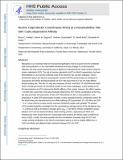| dc.contributor.author | Hadley, Rose Currier | |
| dc.contributor.author | Gagnon, Derek M. | |
| dc.contributor.author | Ozarowski, Andrew | |
| dc.contributor.author | Britt, R. David | |
| dc.contributor.author | Nolan, Elizabeth Marie | |
| dc.date.accessioned | 2021-01-26T15:30:17Z | |
| dc.date.available | 2021-01-26T15:30:17Z | |
| dc.date.issued | 2019-05 | |
| dc.date.submitted | 2019-03 | |
| dc.identifier.issn | 0020-1669 | |
| dc.identifier.issn | 1520-510X | |
| dc.identifier.uri | https://hdl.handle.net/1721.1/129565 | |
| dc.description.abstract | Manganese is an essential metal ion that bacterial pathogens need to acquire from the vertebrate host during infection. In the mammalian nutritional immunity strategy to combat bacterial infection, the host restricts bacterial access to Mn(II) by sequestering this metal nutrient using the protein calprotectin (CP). The role of murine calprotectin (mCP) in Mn(II) sequestration has been demonstrated in vivo, but the molecular basis of this function has not been evaluated. Herein, biochemical assays and electron paramagnetic resonance (EPR) spectroscopy are employed to characterize the Mn(II) binding properties of mCP. We report that mCP has one high-affinity Mn(II) binding site. This site is a His6 site composed of His17 and His27 of mS100A8 and His92, His97, His105, and His107 of mS100A9. Similar to the human ortholog (hCP), Ca(II) binding to the EF-hand domains of mCP enhances the Mn(II) affinity of the protein; however, this effect requires ≈10-fold more Ca(II) than was previously observed for hCP. Mn(II) coordination to the His6 site also promotes self-association of two mCP heterodimers to form a heterotetramer. Low-temperature X-band EPR spectroscopy revealed a nearly octahedral Mn(II) coordination sphere for the Mn(II)-His6 site characterized by the zero-field splitting parameters D = 525 MHz and E/D = 0.3. Further electron-nuclear double resonance studies with globally 15N-labeled mCP provided hyperfine couplings from the coordinating ϵ-nitrogen atoms of the His ligands (aiso = 4.3 MHz) as well as the distal δ-nitrogen atoms (aiso = 0.25 MHz). Mn(II) competition assays between mCP and two bacterial Mn(II) solute-binding proteins, staphylococcal MntC and streptococcal PsaA, showed that mCP outcompetes both proteins for Mn(II) under conditions of excess Ca(II). In total, this work provides the first coordination chemistry study of mCP and reveals striking similarities in the Mn(II) coordination sphere as well as notable differences in the Ca(II) sensitivity and oligomerization behavior between hCP and mCP. | en_US |
| dc.description.sponsorship | NIH (Grants R01GM118695 and R35GM126961) | en_US |
| dc.language.iso | en | |
| dc.publisher | American Chemical Society (ACS) | en_US |
| dc.relation.isversionof | http://dx.doi.org/10.1021/acs.inorgchem.9b00763 | en_US |
| dc.rights | Article is made available in accordance with the publisher's policy and may be subject to US copyright law. Please refer to the publisher's site for terms of use. | en_US |
| dc.source | PMC | en_US |
| dc.title | Murine Calprotectin Coordinates Mn(II) at a Hexahistidine Site with Ca(II)-Dependent Affinity | en_US |
| dc.type | Article | en_US |
| dc.identifier.citation | Hadley Rose C. et al. "Murine Calprotectin Coordinates Mn(II) at a Hexahistidine Site with Ca(II)-Dependent Affinity." Inorganic Chemistry 58, 20 (May 2019): 13578–13590 © 2019 American Chemical Society | en_US |
| dc.contributor.department | Massachusetts Institute of Technology. Department of Chemistry | en_US |
| dc.relation.journal | Inorganic Chemistry | en_US |
| dc.eprint.version | Author's final manuscript | en_US |
| dc.type.uri | http://purl.org/eprint/type/JournalArticle | en_US |
| eprint.status | http://purl.org/eprint/status/PeerReviewed | en_US |
| dc.date.updated | 2020-11-19T19:43:42Z | |
| dspace.orderedauthors | Hadley, RC; Gagnon, DM; Ozarowski, A; Britt, RD; Nolan, EM | en_US |
| dspace.date.submission | 2020-11-19T19:43:45Z | |
| mit.journal.volume | 58 | en_US |
| mit.journal.issue | 20 | en_US |
| mit.license | PUBLISHER_POLICY | |
| mit.metadata.status | Complete | |
